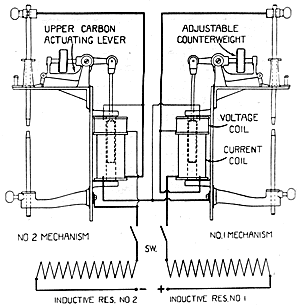
| |
 |
![]()
 The Carbon Arc rods are in contact with each other at the start, only pulled apart to create a
gap when electric current has started to flow. This gap is what creates the arc, and thus, the light.
Here is a Description on a dual lamp mechanism where the gap is controlled by a solenoid,
automatically adjusted by the voltage flowing through.
The Carbon Arc rods are in contact with each other at the start, only pulled apart to create a
gap when electric current has started to flow. This gap is what creates the arc, and thus, the light.
Here is a Description on a dual lamp mechanism where the gap is controlled by a solenoid,
automatically adjusted by the voltage flowing through.
The mechanism developed for the M-R Type 29 twin arc broadside controls each pair of carbon electrodes, independently maintaining the voltage drop across each pair of electrodes at 35 to 40 volts, and the feed of each pair of electrodes is independent of the other and controlled by the voltage drop in the arc that the mechanism controls. This is a schematic diagram showing the method by which this is accomplished. Each carbon arc has its lower carbon electrode in a fixed position. The upper carbon electrode is movable; and when no current flows, the lamp is in contact with the lower carbon. When the lamp is connected to the line, the circuit is closed with only the ballast resistance to impede the flow of current.
The current coils of each mechanism are in series with each other and with the two arcs. The current from the positive side of the line passes through the ballast resistance, 1, into the base of the lamp, through the switch to the control coil of mechanism No. 1, and on to the upper carbon; thence to the lower carbon, into the current coil of mechanism No. 2 through the coil to the other upper carbon, then to the lower carbon, and back to the line through the ballast resistance, 2. The energizing of the circuit actuates the solenoid armatures, which, through their connecting linkages, elevate the upper carbons in each are system, striking both arcs.
Above each current coil, and surrounding each armature, is a coil wound with fine wire and a large number of turns, connected across the arc controlled by it. These coils are wound counter to their respective current coils, and the instant the arc is struck a small current flows through each coil. Since they are shunted across the arcs, the energy introduced into them increases as the voltage drop of each arc increases, the magnetic flux of each voltage coil opposing that of its corresponding current coil. By properly proportioning the number of turns in the current and voltage coils, and proportioning and spacing their respective armatures, it is possible by this method to control the opening of the arc and to maintain quite accurately a uniform voltage drop across the arcs.
A solenoid is a type of electronic piston where the plunger goes back and forth in response to the amount of voltage of current that is applied to it. These devices are extremely common and found in countless electric and electronic components for decades back. Every car will have a number of them. The key will be engineering a simple yet effective feed mechanism using ones found in scrap.
Offered by Brian